Where to eat, drink and stay in Adelaide in 2022
The South Australian capital is stepping out of the shadows of showier cities thanks to elegant eateries, creative spaces and glam new hotels.
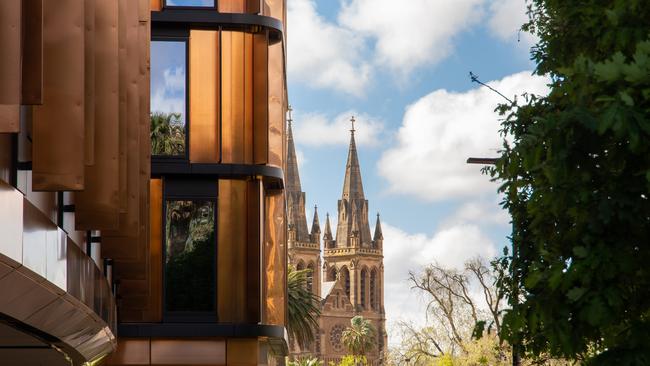
If you haven’t travelled to Adelaide in a while, you’ll notice plenty of changes – a mushrooming skyline, proliferating laneway bars, new festivals joining an already crowded calendar. Locals have long valued the city’s easy lifestyle, content to keep its low-key charms to themselves. But in 2021 Adelaide flew up the global liveability index – number three in the world, number one in Australia – and a fresh dynamism is transforming the urban landscape, delivering new hotels and restaurants and a burgeoning downtown hub with worldly ambitions.
The just-opened world-class Sofitel Adelaide is the latest in a string of hotels to début in recent months, bringing a fat slice of Gallic flair to the West End. Bangkok-based Australian designer Carl Almeida of P49 Deesign has taken several Adelaide tropes – the arts, wine and church architecture – and overlaid them with contemporary French design motifs, including parquet flooring, wall panelling and oh-la-la chandeliers. Entering the $150 million hotel via a laneway off Currie Street leads to a striking porte-cochère, its ceiling covered with a vast lightbox of irises and tulips and rich blue silk riffs on Australian fine-art photographer Alexia Sinclair’s work displayed in the lobby, Field of Dreams, part of a series of lush images inspired by the 18th-century French court. Also in the lobby a vast, sinuous red chandelier twists and curves around reception and into the handsome Déjà Vu Champagne Bar, designed to reflect the city’s River Torrens (Karrawirra Parri) and the red wine both South Australia and Bordeaux are renowned for – and rivers of wine might be just what’s needed right now to mend Aussie-French relations.
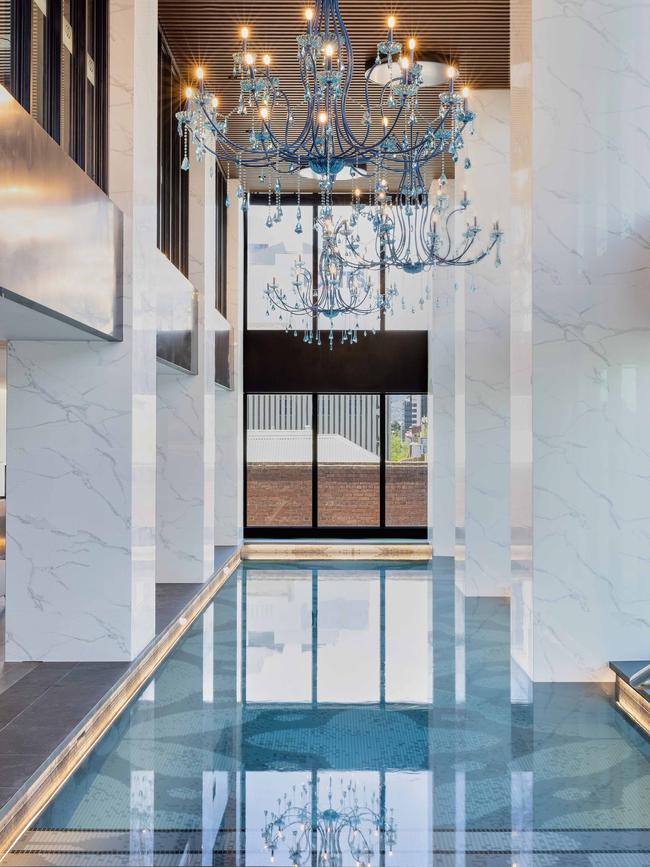
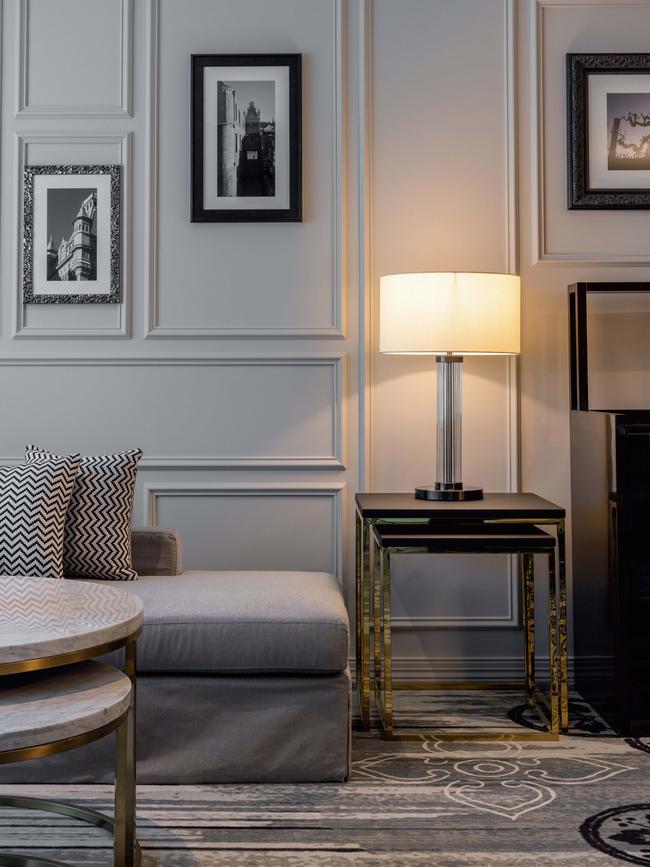
On level nine the hotel’s glamorous brasserie, Garçon Bleu, is everything we miss about Paris. Stunning tiled floors, glistening gold pillars and polished tables, including pour deux, with pale-blue velvet chairs set the scene. The menu, overseen by chef de cuisine Gianni Delogu (ex-Vue de Monde in Melbourne) and executive chef Justin Dingle-Garciyya, who trained under Raymond Blanc, is a roll call of classic French dishes tweaked for a modern Australian palate and served by staff in smart uniforms by Adelaide designer Paolo Sebastian, along with a side of engaging skyline views.
From the leather-padded lifts to the curvaceous bathtubs every detail of the 24-floor hotel is bespoke. Almeida chose materials in concert with property development company Palumbo. Managing director Daniel Palumbo has been intimately involved with the project, travelling to Carrara in Italy with his father, Antonio, to select marble, which was then cut “book-matched” style, an intricate process to mirror the veins among pieces. The result can be seen in the lobby, while marble also features in the restaurant and the dramatic indoor pool illuminated by enormous blue chandeliers. Elsewhere, beautiful parquet flooring sets the scene (three machines were set up specially to cut timbers to Almeida’s specifications).
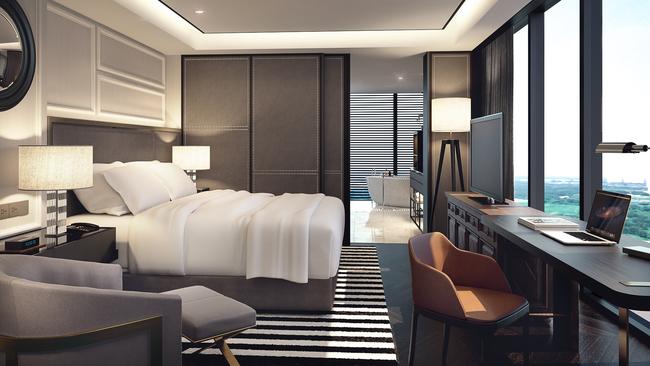
Before commencing the project, Palumbo toured Accor’s Sofitel and SO/ hotels in Asia where Christian Lacroix, Kenzo Takada and Karl Lagerfeld have contributed to interior fit-outs. Following detailed pitches from several designers, Palumbo “fell in love with Almeida’s concepts and when we discovered his Adelaide connection that resonated strongly”. Sofitel’s trademark French poise informs each of the 251 guest rooms and suites with gleaming red candelabra-style lights, pale wall panelling and marble bathrooms, the shower wall decorated with a beautiful, tiled rendering of a city cathedral window. Running the width of the building, the level-24 presidential suite has wraparound views – the distant sea can be spied from the bathtub.
For guests of the hotel’s premium rooms, Club Millésime features an impressive wine lounge behind a bank of deep-blue château-style doors; a lively mural of Belle Époque bon vivants sets the tone. Throughout there are works by Australian and French artists – paintings by Bordeaux-born Nathalie Du Pasquier, for instance, while the restaurant’s decanters are by local glass-blower Nick Mount. The Field of Dreams installation at the entrance is a clue to Palumbo’s own dreams of reviving the Solomon Street art alley behind the hotel, with plans for new outdoor artworks and a breezy bar, Mr Frenchy.
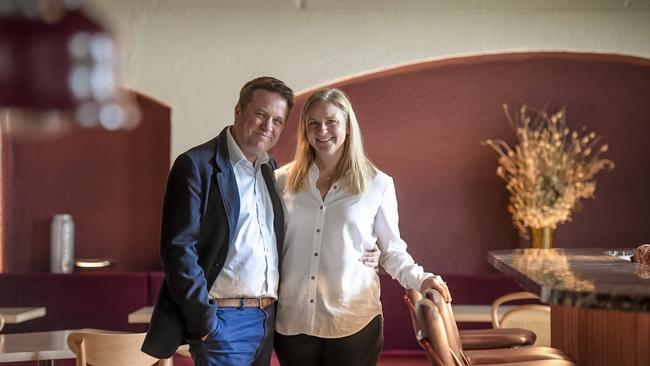
Nearby, on Light Square, philanthropists Sophie and Nick Dunstone are surfing the zeitgeist. Earlier this year, the couple unveiled a groundbreaking, not-for-profit social enterprise that brings together the performing arts, pioneering technology and incredible food. Called Light, the venue occupies a grand 1870 former tobacco store, and gateway to the experience is the brilliant Aurora restaurant headed by chef Brendan Wessels, late of the d’Arenberg Cube in McLaren Vale. The vast warehouse-style performance spaces feature world-leading screen technology, providing a virtual-reality platform for all types of artists, from punk bands to the Australian String Quartet. At a new festival launched in November, Immerse, the headline event involved a 360-degree experience, like an Imax in the round, where special sensors captured visitors’ movements and allowed them to interact with the images on the screen.
The Dunstones are Covid refugees who returned to Adelaide from Hong Kong after 20 years living abroad to discover a city greatly changed. “There’s a palpable undercurrent of social dynamism,” Nick says, “driven by the city’s young and only accentuated during Covid.”
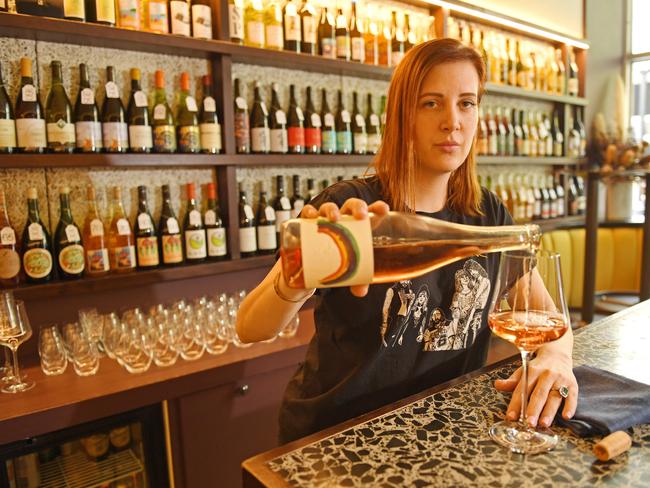
Many locals credit relaxed licensing laws introduced a few years ago with kickstarting a revitalisation of downtown. Bijou watering holes have proliferated across the city, from a smartly upcycled drycleaners, Leigh Street Wine Room, to a little chalet wedged into an alleyway, Pink Moon Saloon. This entrepreneurial spirit is picked up at Lot Fourteen, the rapidly developing future-industries precinct on North Terrace. Historic buildings have been retrofitted to house the Australian Space Agency (and Discovery Centre) – while you’re there grab a coffee or cocktail at Community, a beautifully restored heritage kiosk that has become the precinct’s canteen.
The cornerstone of the project is the national Aboriginal Art and Cultures Centre, slated to open in 2025. The ethereal building, by New York-based Diller Scofidio + Renfro working with Adelaide firm Woods + Bagot, is designed to sit lightly on Kaurna land, the central basket-like space inspired by traditional wurlies and draped in a shimmering woven skin. The building will merge with extensive landscaping, in turn linking to the Adelaide Botanic Garden (Kainka Wirra) and will stand in thrilling counterpoint to North Terrace’s colonial-era set pieces, the art gallery, museum and university.

Sofitel’s début continues a year-long hotel boom that started with the launch of The Oval late last year, cleverly tucked into the super-structure of the Adelaide Oval. Then came the 120-room Eos, part of SkyCity’s $330 million redevelopment, a glittering gold lozenge plopped above the river and claiming the city’s largest standard guest rooms and a resort-style pool deck. Hecker Guthrie and Walter Brooke has deployed a restrained palette of marble, soft metallics and timber in the pared-back rooms, working with the JamFactory and 40 local artists to create more than 900 artworks for the hotel. The result is Zen-like in mood, complete with Japanese-style ceramics.
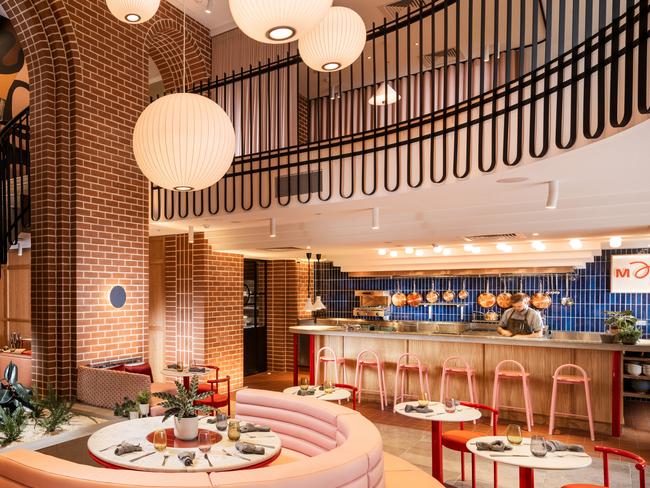
Think zing rather than Zen at the new Hotel Indigo Adelaide Markets, where cheeky local references include pink banquettes and sofas, a homage to the very short pink shorts worn into parliament in 1972 by then-premier and social reformer Don Dunstan. Tucked behind the Adelaide’s historic Central Markets, on the site of a former textile factory, Australia’s first Indigo is intrinsically linked to the neighbourhood, the ground-floor bar and restaurant spilling onto the pavement of narrow Market Street. Brick archways mimic those in the markets, murals enliven walls and the buzzy rooftop bar has some of the best views in town. In the open-plan guest rooms local references include vintage festival posters and colourful rugs picking up on the tessellated tile floors of the city’s Victorian and Edwardian villas.
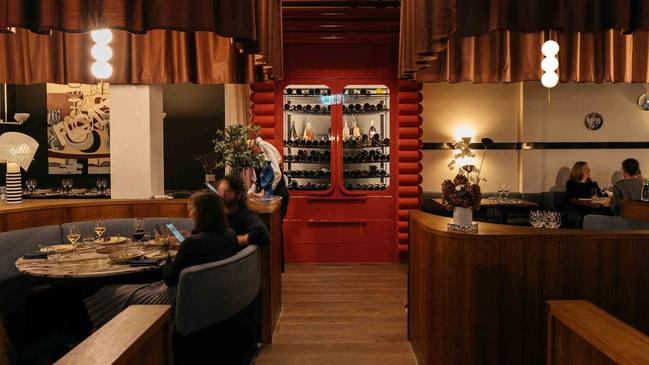
Keeping pace with all this hotel action is a humming restaurant scene. Award-winning architecture firm Studio-Gram has been busy during Covid designing fit-outs for Arkhé in Norwood with chef Jake Kellie, relocated from Singapore’s Michelin-starred Burnt Ends, and the luxe Fugazzi Bar & Dining Room on cobbled Leigh Street. Owned by restaurant wunderkind Simon Kardachi (whose stable of top-flight Adelaide restaurants includes the brilliant Shobosho where chef Adam Liston has just opened a hole-in-the wall ramen shop next door – have the duck rice), Fugazzi combines a sexy Martini bar with a polished dining room featuring velvet drapes and blood-red marble.
“We had a one-word brief: ‘svelte’,” says Studio-Gram director Dave Bickmore. “We channelled 1980s and ’90s New York and Milan, Donnie Brasco, Wolf of Wall Street and New York’s legendary Rao’s.”
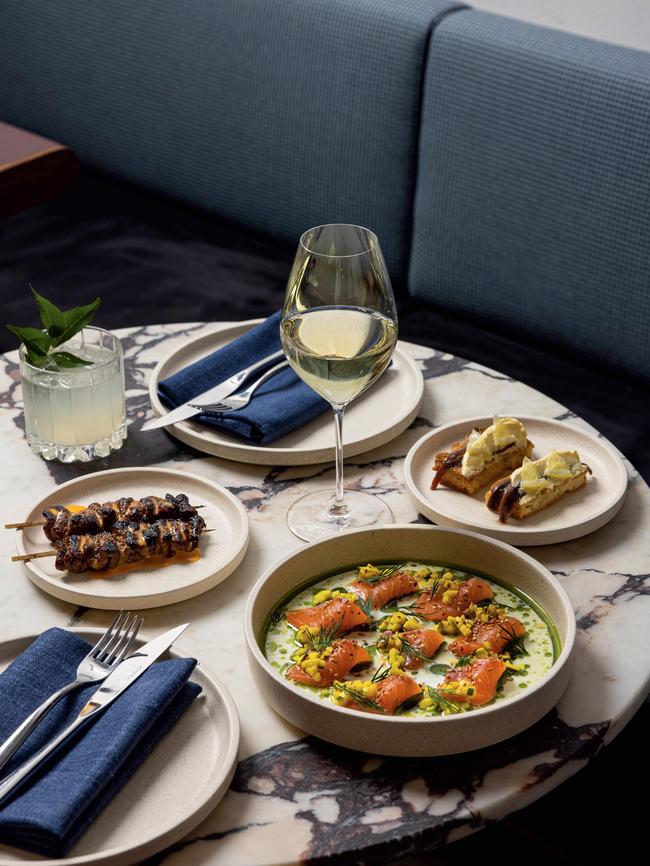

The plush interiors at Fugazzi are emblematic of “a move towards a more elevated dining experience in Adelaide”, he says. “When we started our practice in 2014 all our work was in Sydney. Now the Adelaide hospitality scene is almost stronger than Melbourne or Sydney’s. The city has always had brilliant produce. Design is catching up.”
Dining has been immensely elevated at the Botanic Gardens’ rebooted restaurant. A new name, Restaurant Botanic, with new chef, US-born Justin James, late of Melbourne’s Vue du Monde, is delivering impeccable garden-to-plate menus. The vintage tearoom has been transformed into an inviting dining temple with a schmicko open kitchen creating food that’s pure garden art: scallops nestling in cypress, oysters on samphire, bunya bunya needles flavouring sorbet, all served on bespoke tableware. The gentle update of these charming rooms by Williams Burton Leopardi is suitably botanical, too, with walls painted sage green and great bundles of dried flowers artfully dangling from the vaulted ceiling.

Beyond Adelaide, design is driving a new generation of stylish digs, seen in the world-class likes of Sequoia Lodge at Mount Lofty and the lovely Kingsford the Barossa. Following a two-year revamp of the latter, the former McLeod’s Daughters property, by Stefan and Leanne Ahrens, the old homestead is joined by a new lodge with a smart pool bar and beguiling guest rooms that might be in Puglia with their whitewashed walls and cool, contemporary fit-out (local makers were asked to fashion everything from side tables to cupboard handles). The underground bowling alley is dope (to quote my sons).
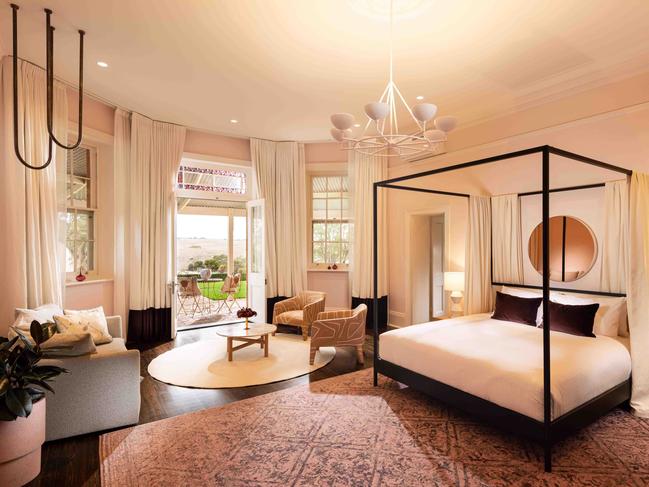
On the other side of the Barossa, Geraldine Frater-Wyeth has transformed an old farmhouse into a chic four-room hotel with great joie de vivre. Le Mas Barossa is laced with 18th-century French antiques, travertine tiles, swish lights and custom mirrors with classical designs etched in glass. A quintessentially French breakfast is served under the 150-year-old fig tree, wines are made in-house, turndown comes with slippers and chocolates. Because some things never go out of style. Just ask anyone in Adelaide.
This article was originally published in December 2021 and has since been updated.



To join the conversation, please log in. Don't have an account? Register
Join the conversation, you are commenting as Logout